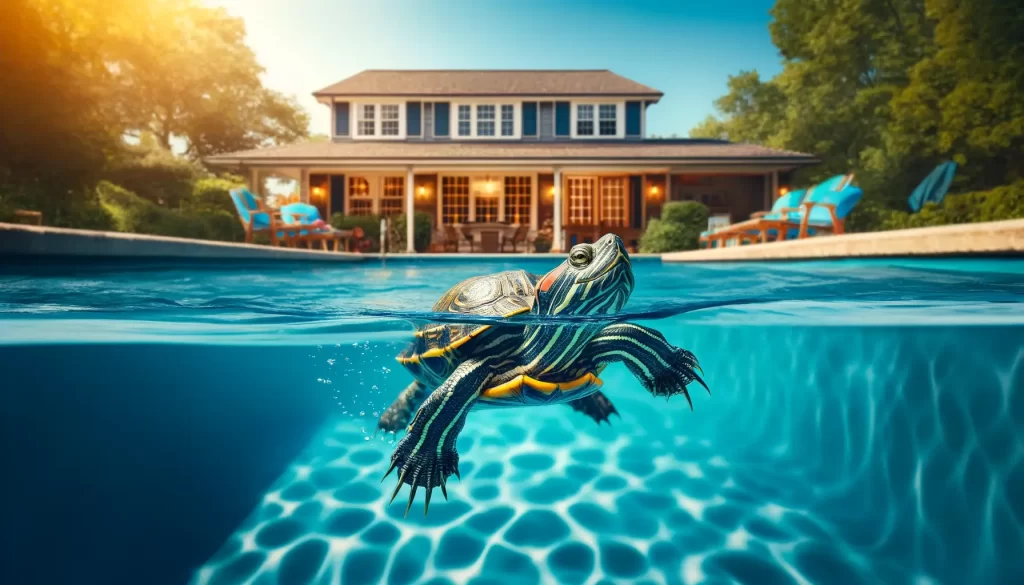Imagine a sunny summer day, and you’re sitting by the pool, enjoying the refreshing water. Suddenly, a thought pops into your head: can turtles swim in chlorine pools?
It’s a curious question indeed. In this article, we will explore whether turtles can navigate and thrive in the chlorinated waters of our beloved swimming pools.
Get ready to unravel the mysteries of these aquatic creatures as we delve into the world of turtles and chlorine pools.
Understanding the Swimming Behavior of Turtles
Turtles are naturally built for aquatic life, and swimming comes naturally to them. With their streamlined bodies and webbed feet, they are well-equipped to navigate through water.
Whether it’s in lakes, rivers, or the ocean, turtles are known for their ability to swim gracefully.
However, when it comes to swimming in chlorine pools, the situation may be a bit different. Turtles are not accustomed to swimming in chemically treated water, and it can have an impact on their behavior.
Therefore, it’s essential to understand the effects of chlorine on turtles and the factors that can affect their ability to swim in such pools.
The Effects of Chlorine on Turtles
Chlorine is a common chemical used in swimming pools to kill bacteria and maintain the water’s cleanliness.
While it helps create a safe swimming environment for humans, it can have adverse effects on turtles.
Exposure to chlorine can irritate turtles’ sensitive skin and eyes. The chemical can cause skin dryness, redness, and even chemical burns.
Moreover, turtles rely on their vision to navigate through water, and the chlorine’s strong odor can hamper their ability to see clearly, causing distress and confusion.
Furthermore, chlorine can also affect turtles’ respiratory system. Turtles breathe air through their lungs, and when swimming in a chlorinated pool, the chemical fumes can irritate their lungs, making it more difficult for them to breathe properly.
Factors Affecting a Turtle’s Ability to Swim in Chlorine Pools
While the presence of chlorine in a pool does pose challenges for turtles, several factors determine their ability to swim in such environments.
One crucial factor is the concentration of chlorine in the pool water. Higher chlorine levels can have a more significant impact on the turtles’ health and comfort.
Lower levels may be more tolerable, but still, it’s important to consider the cumulative effect of repeated exposure over time.
Additionally, the duration of exposure to chlorine also plays a role. Short visits or occasional swims in a chlorinated pool may be less harmful than extended periods of time spent in the water.
Limiting a turtle’s exposure to chlorine can help mitigate the adverse effects.
The size and age of the turtle also contribute to its ability to cope with the chlorinated water.
Smaller or younger turtles may be more vulnerable to the negative effects of chlorine compared to larger, more mature individuals.
This is because their bodies may not have fully developed the capacity to handle the chemical exposure.
Alternatives to Chlorine in Swimming Pools
Considering the potential negative impact of chlorine on turtles, many pool owners and turtle enthusiasts are exploring alternative options for keeping their pools clean without harming these aquatic creatures.
One popular alternative is the use of saltwater chlorinators. These systems use salt to generate chlorine, but in much lower concentrations than traditional methods.
The reduced chlorine levels not only benefit turtles but also create a more comfortable swimming environment for humans.
Another option is ozonation, a process that uses ozone to sanitize pool water. Ozone is a powerful oxidizing agent that effectively eliminates bacteria and other harmful contaminants without the need for chlorine.
This method is generally considered safe for turtles.
Ultraviolet (UV) systems are also gaining popularity as a chlorine alternative. UV rays effectively kill bacteria and other microorganisms in the water, reducing the reliance on chemical disinfection.
These systems can help create a more turtle-friendly pool environment.
Tips for Creating a Turtle-Friendly Environment in Swimming Pools
If you have a turtle and still wish to let it swim in a chlorinated pool, there are steps you can take to create a more turtle-friendly environment:
- Dilute the pool water: Consider diluting the pool water with fresh, clean water to reduce the chlorine concentration. This can help minimize the irritation and discomfort for your turtle.
. - Provide hiding spots: Turtles appreciate places to hide and feel secure, even in a pool. Adding rocks, logs, or other structures in the pool can create hiding spots for them to retreat to when they want to take a break from swimming.
. - Monitor water temperature: Turtles are ectothermic, meaning they rely on external heat sources to regulate their body temperature. Ensure that the pool water is maintained at an appropriate temperature for your turtle’s species to avoid any stress or health issues.
. - Offer basking areas: Turtles need to bask and soak up sunlight to raise their body temperatures and metabolize essential vitamins. Creating basking areas in and around the pool can allow your turtle to take a break from swimming and regulate its body temperature.
The Importance of Regular Water Testing
Regardless of whether you choose to use chlorine or alternative methods to sanitize your pool water, regular water testing is crucial.
Keeping the water chemistry balanced ensures a safe swimming environment for both humans and turtles.
Regular water testing helps maintain proper pH levels, chlorine or alternative sanitizing agent levels, and the overall water quality.
Testing kits are readily available, and following the manufacturer’s instructions can help you keep track of the pool water’s chemical composition.
By testing the water regularly, you can respond promptly to any imbalances or potential issues and take the necessary steps to ensure the well-being of your turtle and other swimmers.
Potential Health Risks for Turtles in Chlorine Pools
While efforts can be made to make a chlorine pool more turtle-friendly, it’s important to be aware of the potential health risks that turtles may still face.
As mentioned earlier, exposure to chlorine can cause skin and eye irritations, leading to redness, dryness, and even chemical burns.
Turtles might also experience respiratory distress from the fumes emitted by the chlorine.
Repeated exposure to chlorine can weaken a turtle’s immune system and make it more susceptible to infections and diseases.
Prolonged exposure can also harm the delicate balance of bacteria in a turtle’s gut, impacting its overall health and well-being.
How to Safely Introduce Turtles to a Chlorine Pool
If you decide to introduce your turtle to a chlorinated pool, it is important to do so gradually and with caution.
Begin by slowly acclimating your turtle to the pool environment. Start by placing it in a container with a small amount of pool water for short periods, gradually increasing the duration and the depth of the water.
This allows the turtle to adapt to the chlorine levels and minimize the shock to its system.
Observe your turtle closely during its first few swims in the pool. Look for signs of distress or discomfort, such as excessive swimming near the edges, clamping limbs, or attempting to climb out of the water.
If any of these behaviors are observed, consider alternative methods or making modifications to improve the turtle’s swimming experience.
Considerations for Outdoor Chlorine Pools
Outdoor chlorine pools present additional considerations when it comes to turtle safety.
One important factor to consider is the exposure to natural sunlight. While turtles require sunlight for their overall health and well-being, excessive exposure to direct sunlight can lead to overheating and other health issues.
Providing shaded areas around the pool or using pool covers can help mitigate these risks.
It is also essential to ensure that the pool is properly secured to prevent turtles from accessing it when not intended.
Turtles, especially certain species, are known for their wandering nature and can accidentally fall into the pool if given the opportunity. Installing barriers, gates, or a pool cover can help keep turtles out when unsupervised.
The Role of Pool Maintenance in Ensuring Turtle Safety
Maintaining a safe and turtle-friendly pool environment goes beyond just choosing the right sanitizing method.
Regular pool maintenance is essential to ensure the well-being of both humans and turtles.
Proper cleaning, filtration, and circulation of the pool water help maintain the water quality and reduce the potential hazards for turtles.
Regularly removing debris and skimming the surface of the water can prevent turtles from ingesting or getting entangled with foreign objects.
Regularly inspecting and maintaining pool equipment, such as pumps and filters, ensures they are functioning correctly.
Malfunctioning equipment can lead to water imbalances or poor water circulation, affecting the overall health of the pool environment.
Final Thoughts
In conclusion, while turtles may have difficulties swimming in chlorinated pools due to the potential adverse effects of chlorine, there are steps that can be taken to create a more turtle-friendly environment.
Exploring alternative pool sanitizing methods, properly acclimating turtles to the pool, and implementing adequate safety measures are all important aspects of ensuring the well-being of turtles in chlorinated pools.
By understanding the impacts of chlorine and taking appropriate precautions, it is possible to enjoy a safe and enjoyable swimming experience for both turtles and humans alike.
Frequently Asked Questions
Q: Is chlorine harmful to turtles?
Yes, chlorine is harmful to turtles as it can damage their skin, eyes, and respiratory system. Turtles require clean, non-chlorinated water to thrive.
Q: What to do if a turtle gets in your pool?
If a turtle gets into your pool, carefully remove it using a net or by gently lifting it from the water. Place it in a safe, shaded area and provide a shallow container of non-chlorinated water until you can release it into an appropriate natural habitat or contact a wildlife rehabilitator for further guidance.
Q: What happens if a turtle falls into a pool?
If a turtle falls into a pool, it can be at risk of chlorine exposure and drowning if it cannot easily exit. It’s important to remove the turtle as quickly as possible to prevent harm.
Q: Can a turtle live in a kiddie pool?
A turtle can temporarily live in a kiddie pool if the water is clean and non-chlorinated. However, the environment should include basking areas and proper filtration to keep the water clean, and the water should be changed regularly.
Q: Can aquatic turtles live in dirty water?
Aquatic turtles should not live in dirty water as it can lead to health problems including infections, shell rot, and respiratory issues. Clean, well-filtered water is essential for their health.
Q: How long can turtles live in outside water?
Turtles can live in outside water such as ponds or lakes their entire lives as long as the environment is suitable and the water quality is maintained. In captivity, it’s crucial to replicate natural conditions as closely as possible.




